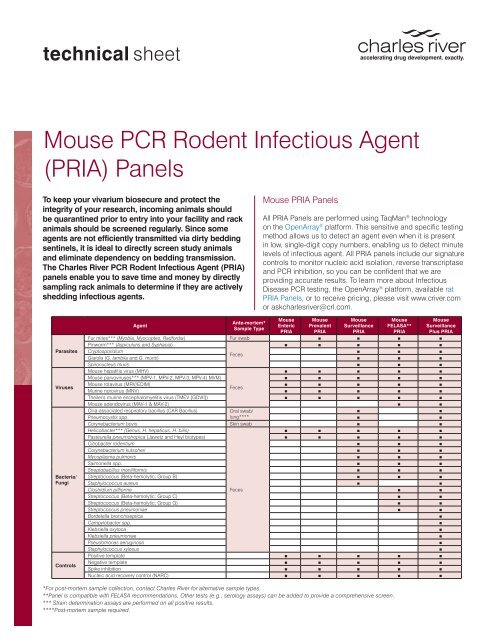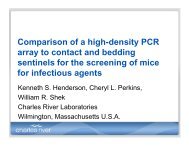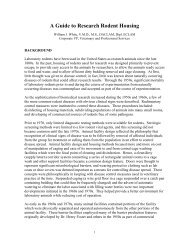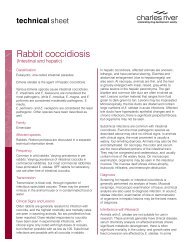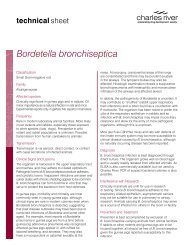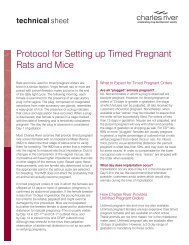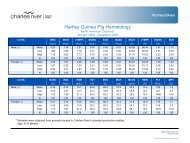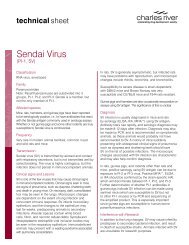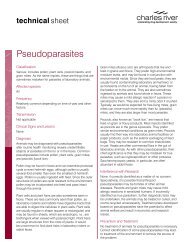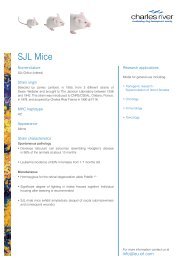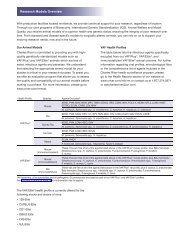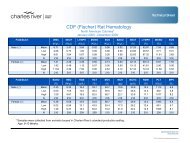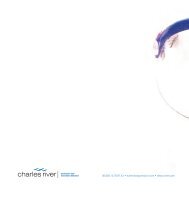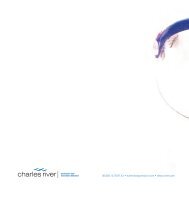Mouse PCR Rodent Infectious Agent (PRIA) Panels | Charles River
Mouse PCR Rodent Infectious Agent (PRIA) Panels | Charles River
Mouse PCR Rodent Infectious Agent (PRIA) Panels | Charles River
Create successful ePaper yourself
Turn your PDF publications into a flip-book with our unique Google optimized e-Paper software.
technical sheet<br />
<strong>Mouse</strong> <strong>PCR</strong> <strong>Rodent</strong> <strong>Infectious</strong> <strong>Agent</strong><br />
(<strong>PRIA</strong>) <strong>Panels</strong><br />
To keep your vivarium biosecure and protect the<br />
integrity of your research, incoming animals should<br />
be quarantined prior to entry into your facility and rack<br />
animals should be screened regularly. Since some<br />
agents are not efficiently transmitted via dirty bedding<br />
sentinels, it is ideal to directly screen study animals<br />
and eliminate dependency on bedding transmission.<br />
The <strong>Charles</strong> <strong>River</strong> <strong>PCR</strong> <strong>Rodent</strong> <strong>Infectious</strong> <strong>Agent</strong> (<strong>PRIA</strong>)<br />
panels enable you to save time and money by directly<br />
sampling rack animals to determine if they are actively<br />
shedding infectious agents.<br />
Parasites<br />
Viruses<br />
Bacteria/<br />
Fungi<br />
Controls<br />
<strong>Agent</strong><br />
Ante-mortem*<br />
Sample Type<br />
<strong>Mouse</strong> <strong>PRIA</strong> <strong>Panels</strong><br />
All <strong>PRIA</strong> <strong>Panels</strong> are performed using TaqMan ® technology<br />
on the OpenArray ® platform. This sensitive and specific testing<br />
method allows us to detect an agent even when it is present<br />
in low, single-digit copy numbers, enabling us to detect minute<br />
levels of infectious agent. All <strong>PRIA</strong> panels include our signature<br />
controls to monitor nucleic acid isolation, reverse transcriptase<br />
and <strong>PCR</strong> inhibition, so you can be confident that we are<br />
providing accurate results. To learn more about <strong>Infectious</strong><br />
Disease <strong>PCR</strong> testing, the OpenArray ® platform, available rat<br />
<strong>PRIA</strong> <strong>Panels</strong>, or to receive pricing, please visit www.criver.com<br />
or askcharlesriver@crl.com.<br />
<strong>Mouse</strong><br />
Enteric<br />
<strong>PRIA</strong><br />
<strong>Mouse</strong><br />
Prevalent<br />
<strong>PRIA</strong><br />
<strong>Mouse</strong><br />
Surveillance<br />
<strong>PRIA</strong><br />
*For post-mortem sample collection, contact <strong>Charles</strong> <strong>River</strong> for alternative sample types.<br />
**Panel is compatible with FELASA recommendations. Other tests (e.g., serology assays) can be added to provide a comprehensive screen.<br />
*** Strain determination assays are performed on all positive results.<br />
****Post-mortem sample required.<br />
<strong>Mouse</strong><br />
FELASA**<br />
<strong>PRIA</strong><br />
<strong>Mouse</strong><br />
Surveillance<br />
Plus <strong>PRIA</strong><br />
Fur mites*** (Myobia, Myocoptes, Radfordia) Fur swab ■ ■ ■ ■<br />
Pinworm*** (Aspiculuris and Syphacia)<br />
■ ■ ■ ■ ■<br />
Cryptosporidium<br />
Giardia (G. lamblia and G. muris)<br />
Feces<br />
■<br />
■<br />
■<br />
■<br />
■<br />
■<br />
Spironucleus muris ■ ■ ■<br />
<strong>Mouse</strong> hepatitis virus (MHV)<br />
■ ■ ■ ■ ■<br />
<strong>Mouse</strong> parvoviruses*** (MPV-1, MPV-2, MPV-3, MPV-4) MVM) ■ ■ ■ ■ ■<br />
<strong>Mouse</strong> rotavirus (MRV/EDIM)<br />
Murine norovirus (MNV)<br />
Feces<br />
■<br />
■<br />
■<br />
■<br />
■<br />
■<br />
■<br />
■<br />
■<br />
■<br />
Theiler's murine encephalomyelitis virus (TMEV [GDVII]) ■ ■ ■ ■ ■<br />
<strong>Mouse</strong> adendovirus (MAV-1 & MAV-2) ■ ■<br />
Cilia-associated respiratory bacillus (CAR Bacillus) Oral swab/<br />
■ ■<br />
Pneumocystis spp. lung****<br />
■ ■<br />
Corynebacterium bovis Skin swab ■ ■<br />
Helicobacter*** (Genus, H. hepaticus, H. bilis)<br />
■ ■ ■ ■ ■<br />
Pasteurella pneumotropica (Jawetz and Heyl biotypes) ■ ■ ■ ■ ■<br />
Citrobacter rodentium ■ ■ ■<br />
Corynebacterium kutscheri ■ ■ ■<br />
Mycoplasma pulmonis ■ ■ ■<br />
Salmonella spp. ■ ■ ■<br />
Streptobacillus moniliformis ■ ■ ■<br />
Streptococcus (Beta-hemolytic; Group B) ■ ■ ■<br />
Staphylococcus aureus ■ ■<br />
Clostridium pilfiorme Feces<br />
■ ■<br />
Streptococcus (Beta-hemolytic; Group C) ■ ■<br />
Streptococcus (Beta-hemolytic; Group G) ■ ■<br />
Streptococcus pneumoniae ■ ■<br />
Bordetella bronchiseptica ■<br />
Campylobacter spp. ■<br />
Klebsiella oxytoca ■<br />
Klebsiella pneumoniae ■<br />
Pseudomonas aeruginosa ■<br />
Staphylococcus xylosus ■<br />
Positive template ■ ■ ■ ■ ■<br />
Negative template ■ ■ ■ ■ ■<br />
Spike inhibition ■ ■ ■ ■ ■<br />
Nucleic acid recovery control (NARC) ■ ■ ■ ■ ■
technical sheet<br />
Suggested Uses of <strong>PRIA</strong><br />
Health concerns vary greatly with facility size and research type.<br />
<strong>PRIA</strong> panels have many potential applications to augment your<br />
health surveillance programs:<br />
• Alternative to shipping live animals for diagnostic<br />
testing in the midst of extreme temperatures<br />
• Expedite quarantine by learning the health status<br />
of incoming animals within two weeks of arrival<br />
(see “Quarantine Testing”)<br />
• Minimize animal use by augmenting sentinel-based health<br />
surveillance programs (see “Routine Health Monitoring”)<br />
• Verify that study animals are free from infection at a<br />
specific time point<br />
• Confirm the health of rederived pups by screening the<br />
embryo-transfer (ET) recipient female post-weaning<br />
• Assess biosecurity risk by testing live-trapped rodents<br />
or feces found in bait stations<br />
Please contact us at askcharlesriver@crl.com to discuss how <strong>PRIA</strong><br />
panels can be incorporated into your specific program.<br />
Quarantine Testing:<br />
The <strong>PRIA</strong> panels can be used to augment your rodent quarantine<br />
testing program by directly screening principal animals, allowing<br />
you to determine if prevalent viruses and bacteria are actively<br />
being shed. The <strong>PRIA</strong> panels allow you to reduce rodent<br />
quarantine time since the dependency on seroconversion is<br />
eliminated.<br />
A few days after animals arrive, multiple samples can be<br />
collected from each animal and screened via the <strong>PRIA</strong> panel of<br />
your choice. It is best to only pool samples from within the same<br />
group during quarantine testing. It is also important for each<br />
rodent in a quarantine group to be represented in the testing<br />
process, as each animal can be in a different stage of infection.<br />
Results from <strong>PRIA</strong> panels are meant to corroborate pre-existing<br />
health reports from the exporting institution. Similar to bedding<br />
sentinel quarantines, 9-12 months (three to four quarters) of<br />
health report data from the source facility should be reviewed<br />
and compared with the <strong>PRIA</strong> panel results to confirm agreement.<br />
<strong>PRIA</strong> testing should be used to verify the health status and detect<br />
other agents not listed on the health report history. Unexpected<br />
positive and negative results that may impact your biosecurity<br />
specifications should always be investigated and verified by<br />
confirmation testing. If a sample results in a positive finding, you<br />
can take the appropriate action to manage the contamination<br />
immediately and reduce the potential spread of infection.<br />
Routine Health Monitoring:<br />
The <strong>PRIA</strong> panels can also be used to supplement your routine<br />
rodent health surveillance program. Since most sample types<br />
are non-invasive, <strong>PRIA</strong> panels can scren rack or study animals<br />
easily, without using extra animals for sentinels.<br />
In general, we do not recommend <strong>PRIA</strong> panels as a complete<br />
replacement for whole animal monitoring program, as there can<br />
be a “detection-gap” for infectious that quickly spread and clear.<br />
Consider using <strong>PRIA</strong> panels as an add-on to traditional live animal<br />
health monitoring to look for key agents (such as fur mites or<br />
pinworms) using gold standard methods as well as <strong>PCR</strong>.<br />
<strong>PRIA</strong> <strong>Panels</strong> can also be used when weather restricts the<br />
shipment of live animals for diagnostic testing.<br />
Sample Pooling<br />
You can pool samples from up to 10 mice. Each pooled sample<br />
type must be kept separate from the others: fecal pellets, oral<br />
swab/nasal aspirate/lung wash, and skin/fur swab (see table<br />
for sample types). The <strong>PRIA</strong> process does not accommodate<br />
the pooling of multiple lung tissues, therefore only one lung<br />
specimen can be submitted along with the pooled sample set.<br />
Each sample type group will be pooled in our laboratory. Our<br />
processes allow us to pool the genetic material extracted from<br />
multiple sample types (e.g., feces, oral swab and skin swab)<br />
and test together with one result reported.<br />
Sample Specifications, Storage and Submission<br />
All samples must be accompanied by a completed <strong>PCR</strong> <strong>Rodent</strong><br />
<strong>Infectious</strong> <strong>Agent</strong> (<strong>PRIA</strong>) <strong>Panels</strong> Sample Submission Form (found<br />
online at www.criver.com/info/diagnostic_sample_submission);<br />
sampling recommendations, sample storage requirements and<br />
submission instructions can be found in this document.<br />
To ensure that your samples arrive safely at our laboratory, we<br />
provide International Air Transport Association (IATA)-compliant<br />
shipping materials (sample submission vials/swabs, submission<br />
forms, shipping labels, containers, etc.) free of charge to all<br />
<strong>Charles</strong> <strong>River</strong> Research Animal Diagnostic Services customers.<br />
To request materials, simply complete our Diagnostic Services<br />
Shipping Materials Request Form (www.criver.com/info/quotes)<br />
prior to sample submission.<br />
askcharlesriver@crl.com<br />
www.criver.com<br />
© 2011, <strong>Charles</strong> <strong>River</strong> Laboratories International, Inc.


